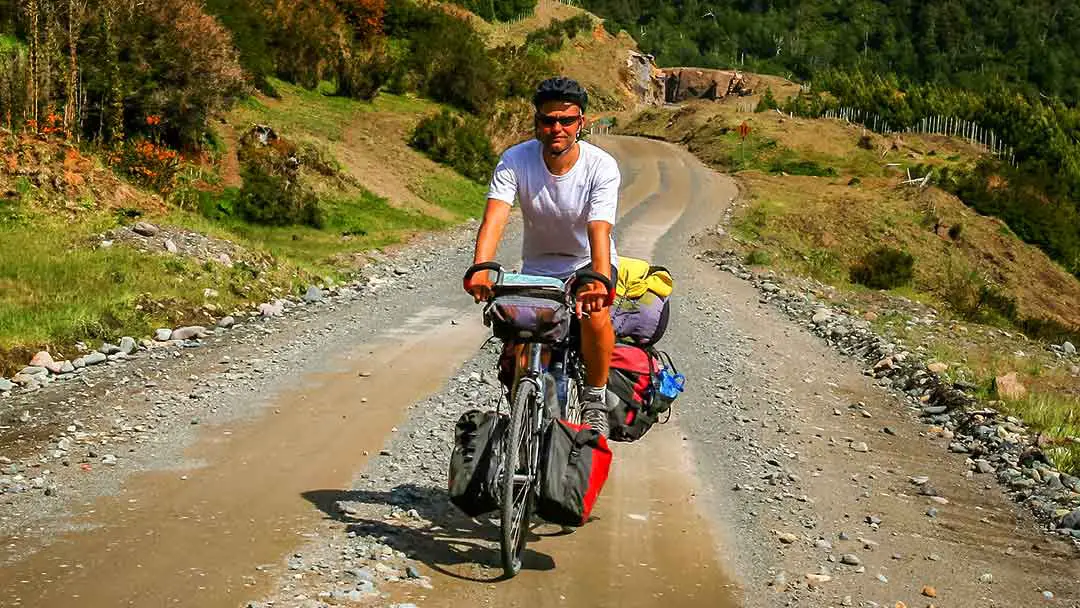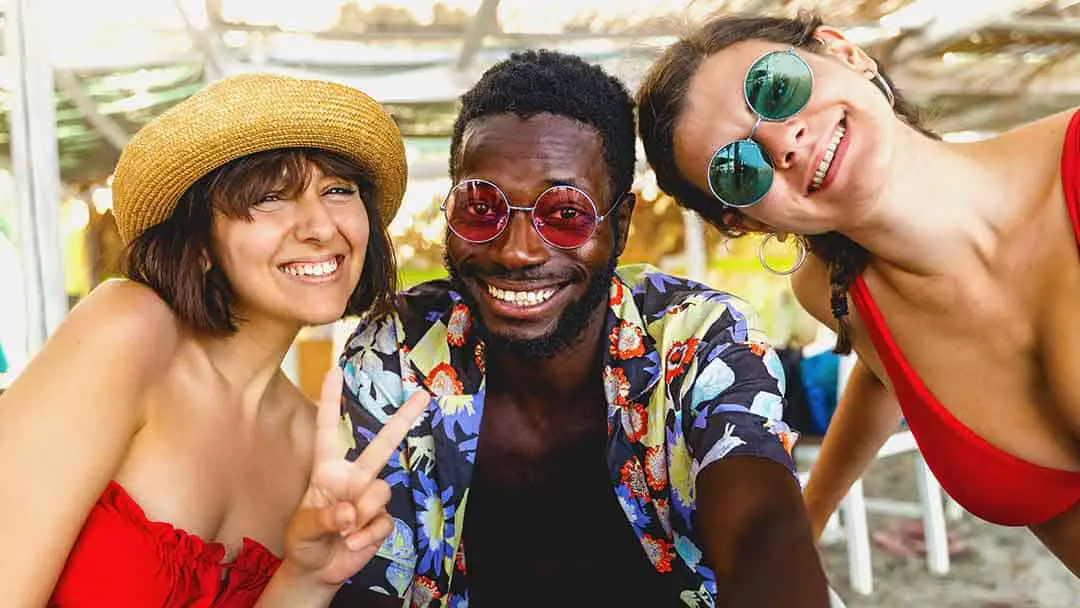Bikepacking VS Touring Compared | What’s The Difference?

As an Amazon Associate we earn from qualifying purchases made on our website. If you make a purchase through links from this website, we may get a small share of the sale from Amazon and other similar affiliate programs. You can read our complete legal information for more details. By using this site, you agree the information contained here is for informational purposes only. For specific medical questions, consult your doctor. NO information on this site should be used to diagnose, treat, prevent or cure any disease or condition.
I first started biking at my grandma’s farm in New Jersey when I was six years old. In my twenties, I rediscovered this old passion and started mountain biking in the hills of West Virginia. I didn’t know it at the time, but I was taking my first steps into the world of bikepacking!
The main difference between these experiences is where they take place and how the biker packs. Bikepacking is typically an off-road long-distance biking experience that spans several days or weeks. Bicycle touring is usually a long-distance excursion that primarily takes place on paved roads.
While the two excursions seem very similar, they have many distinctive characteristics. If you’re curious about which is suitable for you, then you’ve come to the right place!
What is Bikepacking?
Bikepacking is a form of offroad biking that allows the rider to enjoy the journey for a longer time. Regular offroad biking can last only several hours, while bikepacking can last days or weeks. Taking along a tent, some food, and water allows you to sustain your adventures outside.
Although the definition seems pretty straightforward, there’s still a lot of disagreement about what it involves. According to an interview video of several experts by Bikepacking.com, bikepacking means different things to each person.
But, most agree that this activity includes some of the following:
- Carrying enough supplies to last a few days
- Having a light-weight bike
- Outdoor, offroad adventures
- Traveling without panniers and luggage
- Avoiding highways and noise
- Immersing in local cultures
- A challenge
Bikepacking combines offroad biking with the convenience of backpacking. The goal of bikepacking is to bring the thrills of offroading with the joys of hiking through nature.
Even though the definition is hard to pin down, the general activities and goals are well understood by practitioners. To sum up the definition of bikepacking, it’s an offroading experience that blends biking with backpacking.
For those unaware, backpacking is a cheaper form of international travel. People who backpack through countries are known as “backpackers” due in part to their noticeable backpacks.
These adventurers can travel up to ten miles per day and often traverse through several countries. However, bikepacking allows travelers to knock out even more miles daily and see more of the world! Not only that, it will enable the riders to engage both passions of travel and biking in one activity.

How is Bikepacking Different From Bike Touring?
The primary difference between bikepacking and bike touring is where travelers tend to visit. Bikepacking traverses the off-beating paths which lead through scenic forests or other nature paths. Cycling tours usually travel through counties via the nation’s main roadways or city side streets.
Let’s first explore what these two cycling activities have in common. They both include:
- Long distance cycling
- Sometimes involve endurance cycling
- Exploring local communities
- Traversing between countries
- Bringing supplies
- Sleeping in tents
However, the how and where differ somewhat significantly between these activities. Cycling tours differ from bikepacking in the following ways:
- Almost always stay on paved roads
- Bring more supplies
- Utilize panniers and luggage
- A more affordable way to travel
Bike tours are notably heavier yet cheaper experiences. Cycling tour bicyclists usually purchase a heavy-weight bike to meet the journey’s needs. Travelers typically choose thick tires and frames to prevent road damage and punctures.
These bikers usually bring a decent amount of supplies in bags or panniers. They sometimes bring cooking utensils for cooking over campfires as well as tents and food. This makes the travel heavier but cheaper since they don’t have to stop at restaurants on the way!
Who Should Go Bikepacking?
Bikepacking is a favorite activity of cyclists, gymnasts, and other outdoor or health enthusiasts. Although almost anyone can go bikepacking, it’s best to be in good health. Bikepacking can sometimes be complex and intense, so make sure you’re ready for the challenge.
Bikepacking is ideal for younger people looking to connect more closely to the surrounding natural environment. However, young people aren’t the only ones who enjoy this activity.
People in their 60s, 70s and even 80s have enjoyed this activity without many issues. This biggest bar of entry is your overall health and physical capabilities.
Bikepacking, much like a tour, is a physically draining experience. If you suffer from one or multiple of the following conditions, bikepacking might be more difficult (but not necessarily impossible):
- Heart issues
- Excessive weight
- Extreme joint or muscle pain
- Epilepsy
- Pregnancy
- Skin cancer
This is not an exhaustive list, but it provides some insights into the intensity of the exercise. Cycling is one of the best forms of exercise, but it can be intense on the heart. Additionally, if you have physical disabilities, the terrain may hurt or harm the body more than it would others.
The Global Cycling Network suggests that those with pre-existing heart conditions use a heart monitor when cycling. This will help you track your heart rate and ensure your BPMs remain under a certain level.
Certain medications can help you grapple with epileptic seizures, but make sure you travel with a companion. Traveling with a companion is always safer, regardless of whether you have any pre-existing conditions.
There are ways to overcome these struggles, though. Always consult your doctor before embarking, and train before leaving on your excursion in the wild.

Bikepacking Bike Setup VS Bike Touring Setup
Bikepackers usually travel light. Their bikes are not as heavy as touring bikes, and these bikers travel significantly lighter. They may only bring a backpack with a tent and basic supplies.
Lightweight
Bikepacking bikes are typically lighter than touring bikes because they’re built with more lightweight materials. However, even when fully loaded for the journey, they are significantly lighter and less cumbersome than touring bikes.
Most bikepacking bikes weigh between 37-77 pounds. Touring bikes can weigh up to 110 pounds when fully loaded for the journey. This changes the biker’s experience of the trip and can be difficult on rough terrain.
Made for Comfort
The lightweight materials that make backpacking bikes allow them to glide more easily over rocky or dusty ground. It also makes climbing uphill much easier and less intense when traveling far distances.
These bikes typically have softer plush seats and better suspension than touring bikes. This is because bikepackers typically traverse rough, uneven, and unpaved pathways. This could quickly wear out the rider, especially when traveling 80 or more miles daily.
Efficient
Bikepacking setups are made for long-distance biking. They’re also designed to minimize effort and energy expenditure to support the minimalist nature of this offroad venture.
Since bikepacking doesn’t allow for several bags of supplies like touring, they must be efficient. Otherwise, the biker will burn all the calories they consume and more without sufficient supplies to replenish them.
We go even deeper on bik difference here in this article: Touring Bike Vs. Gravel Bike | What’s the difference?
Pros and Cons of Bikepacking and Touring
Bikepacking and bike touring are two different activities, even though they overlap significantly. Therefore, the pros and cons of each of these activities are based on what the individual is seeking.
Additionally, each of these terms has a somewhat broad application. While bike touring is typically a slower-paced, less intense experience, it can also be a high-speed trip. It depends upon what type of tour you wish to take.
Similarly, some bikepacking experiences are intense treks that last several weeks. Other experiences are less intense and only take a day or two on moderate hiking trails.
Generally, the positives of bikepacking include:
- Combines hiking and off-road biking
- Indulge in nature
- Quiet
- See less known places
- Challenge your abilities
- Self-sustaining travel with a tent
- Lightweight
Bikepacking allows the rider to immerse themselves in the world around them entirely. While touring is a great way to travel, it can sometimes be loud, chaotic, and crowded. Bikepacking is preferably for relieving stress and embracing the natural environment.
Some negative aspects of bikepacking include:
- Limited storage space
- Cost of food
- Packing gear is complex
- Lack of comfort
Bike touring is typically slower-paced and consists of more luggage. This can make the experience more cumbersome, but it affords several luxuries not available in bikepacking.
Cycle touring is ideal for families, especially for those with children. Bikepacking is better for solo venturers or adults. Bringing children on a bikepacking trip can be difficult.
Last, cycle touring is a cheaper venture. The luggage and panniers mean you can bring food, cooking supplies, and other conveniences on the road. This saves significant money since you won’t have to stop at restaurants or roadside food stands.
Not sure where and how to camp when bikepacking and touring? No worries, this article drops important and useful info.

Final Thoughts
Bikepacking is an exciting and life-changing experience for any biking enthusiast looking to explore the wild. Although bicycle touring and bikepacking have long-distance biking in common, their differences are notable.
Whether bikepacking or cycle touring is the right choice is primarily a personal choice. However, we hope this article helped you make your decision.
Keep your health, safety, and personal needs in mind when choosing. Both are exciting, but they might not be for everyone. Whichever you decide to use for your trip, we’re confident it’ll be one of the best journeys of your life!
Sources:
Bikepacking.com: YouTube: What is Bikepacking?
Answer Travel: What is Backpacking?
REI.com: How to Plan a Backpacking Trip
Global Cycling Network: Essential Information For Cyclists | How Safe Is Your Heart?



